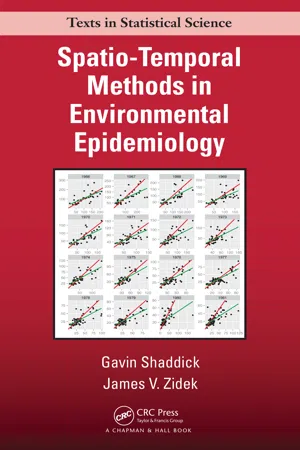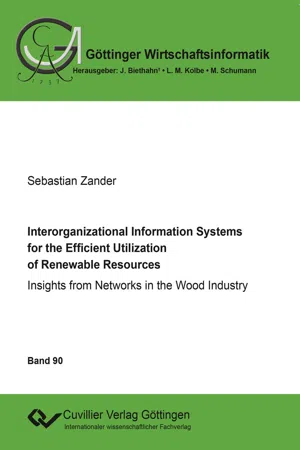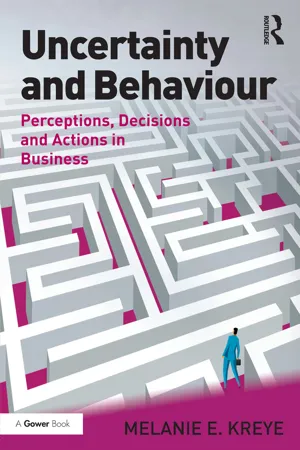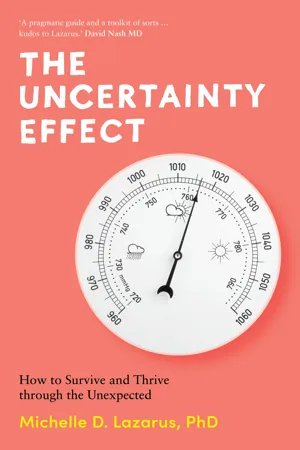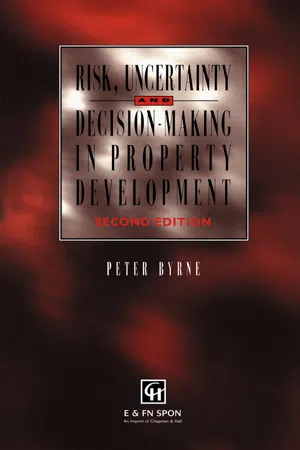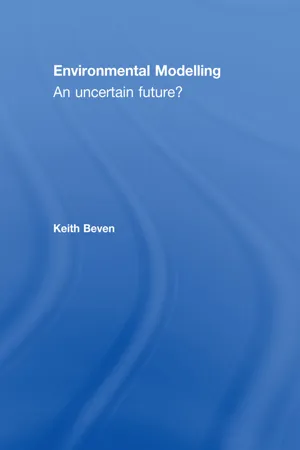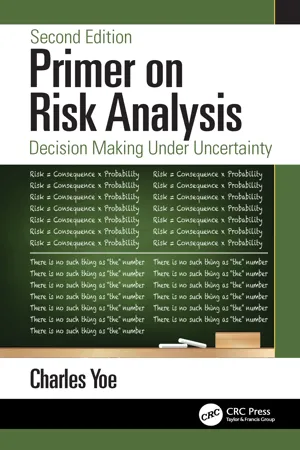Business
Business Uncertainty
Business uncertainty refers to the lack of predictability or clarity in the business environment, often stemming from factors such as market fluctuations, regulatory changes, or technological advancements. It can impact decision-making, strategic planning, and investment, leading to hesitation and risk aversion among businesses. Managing and mitigating uncertainty is crucial for organizations to adapt and thrive in dynamic markets.
Written by Perlego with AI-assistance
Related key terms
1 of 5
10 Key excerpts on "Business Uncertainty"
- eBook - ePub
Risk Management in Crisis
Winners and Losers during the COVID-19 Pandemic
- Piotr Jedynak, Sylwia Bąk(Authors)
- 2021(Publication Date)
- Routledge(Publisher)
Possibility of the occurrence of a potentially harmful event (Freeston et al., 1994) Possibility of the occurrence of a negative event (Dugas et al., 2001) Possibility of the occurrence of unforeseeable negative events (Carleton et al., 2010)As can be seen from Table 1.1 , uncertainty is the most often equated with events characterized by unpredictability, with negative consequences being the most frequently expected results. Context-sensitive proposals can also be found among the definitions examined, for example with respect to decision-making processes or available knowledge resources, which results in the lack of an unambiguous definition of uncertainty within the context of management.Uncertainty is also quite often used when defining risk, as a concept with a narrower scope, a higher level of concretization and a more real character.1.2.2. The defining of risk
Risk in itself is regarded as a universal concept, applicable in both science and all dimensions of business life: economic, social and political (Śliwiński, 2002). Similarly to the case of uncertainty, the ways in which risk is defined in the scientific literature are characterized by great diversity, which can be justified by the number and diversity of scientific disciplines on the basis of which risk is interpreted and attempts at its operationalization are made (Spekman and Davis, 2004; Elahi, 2013). With regard to management sciences, it is possible to indicate attempts to define risk both conceptually and in the area of sub-disciplines of management science, such as quality management, strategic management or risk management – a sub-discipline directly dedicated to the role of risk in business management (Kaczmarek, 2006). - eBook - ePub
Entrepreneurship in the Third World
Risk and Uncertainty in Industry in Pakistan
- Zafar Altaf(Author)
- 2023(Publication Date)
- Routledge(Publisher)
Chapter Four Uncertainty and RiskIn any economy opportunities exist, and although dependent on various factors, these opportunities may vary considerably. The appreciation or rather the perception of these opportunities impels the would-be entrepreneurs towards translating their ideas into action. Each entrepreneur, as a result, views these opportunities and the consequences thereof in their own individualistic way, and in that sense each perception is unique to the entrepreneur.Two consequences emerge as a result. Frank Kinight, considered these two aspects as uncertainty and risk (1 ). The entrepreneurs as a result of converting their ideas into action bear the responsibility and consequences of such decisions. This identification enabled the entrepreneurs to differentiate between uncertainty and risk. When conditions were uncertain the situation was such as to defy quantification. A ‘gut’ feeling in such a situation was not possible as in this part of the real world probability determination has no meaning. Uncertainty brings with it violent and volatile situations. The intensity of the uncertain conditions in Pakistan during the period 1968–72 (2 ) could not have been perceived under any kind of probabalistic determinism (3 ). There is no way to foresee the future and therefore no way to cover up these eventualities. In the Third World, despite government involvement, institutions cannot be created to cover such kinds of uncertainty.The associative aspect of uncertainty i.e. risk can be computed. Under such circumstances risk computation can mean reduction of uncertainty. Even here accurate powers of prediction are required, which are more or less non existent. Institutions normally operating in the less developed world do not cover even risk. Whatever risk coverage exists is dependent on the government of the day and to the insurance companies (to a very limited extent). - Available until 5 Dec |Learn more
- Gavin Shaddick, James V. Zidek(Authors)
- 2015(Publication Date)
- Chapman and Hall/CRC(Publisher)
Chapter 3 The importance of uncertainty 3.1 Overview Uncertainty is a topic that permeates all scientific inquiry and its importance is mag-nified when the results are applied in decision-making, which in this setting will involve legislation, regulations and designing public policy. Despite the general importance of the concept of ‘uncertainty’, its meaning lacks a universally agreed on definition. In fact it shares its general lack of definition with ‘information’, as described by the late Debabrata Basu (Basu, 1975): “But what is information? No other concept in statistics is more elusive in its meaning and less amenable to a generally agreed definition.” It has been described in various ways including ‘incomplete knowledge in relation to a specified objective’ which arises ‘due to a lack of knowledge regarding an unknown quantity’ (Bernardo & Smith, 2009). However, the lack of a clear cut definition has not stopped people from taxonomizing it! Thus we have for example the distinction between aleatory (stochastic) and epistemic (subjective) uncertainty (Helton, 1997). It seems generally agreed that some aspects of uncertainty are quantifiable while oth-ers are inherently qualitative, that is not subject to quantification. The latter would, for example, include framing the problem to be investigated by defining the system boundaries and explicating the role of values (van der Sluijs et al., 2005). Both qual-itative and quantitative aspects of uncertainty need to be taken into account within environmental risk analyses. There will often be intangible sources of uncertainty which will arise through the subjective judgements that are sometimes required to estimate the nature and mag-nitude of empirical quantities where other methods are not appropriate. Uncertainty may arise as a result of imprecise language in describing the quantity of interest and disagreement about interpretation of available evidence. - eBook - PDF
Harvard Business Essentials, Decision Making
5 Steps to Better Results
- (Author)
- 2005(Publication Date)
- Harvard Business Review Press(Publisher)
The Uncertainty Problem Key Topics Covered in This Chapter • A three-step process for dealing with decision uncertainty • Business tactics for dealing with uncertainty • How and when to follow your intuition How to Deal with Unknowns 7 I f you are like most people, uncertainty—that is, risk— is a major impediment to making good decisions—or to making decisions at all. Every decision involves a trip through foggy patches of uncertainty because decisions are about the future, an unwritten story for which there are no facts. Most of us rely on what we know about the past to provide in-sights into the future. What we know of the past and the present can help us understand where we are, where we have been, and what the general trajectory of our journey looks like. But the past and present provide nothing more than hints about the future. As Coleridge put it, “History is a lantern at the stern of a ship, revealing only where it has been,” casting only a dim light on the course ahead. Consider these typical examples of decision uncertainties: Yes, we can raise our prices, but how will our customers respond? Should I order one thousand units or five thousand? I’ll get a volume discount on the larger order, and that will save me money on every unit.That’s certain. But I’m not sure I can sell five thousand without cutting the price. We like this strategic plan. It seems sound, and it will differentiate us in a way that customers will appreciate. But our competitors aren’t stupid; they won’t sit on their hands and let us run all over them. Can anyone tell me what our competitors are likely to do to counter our new strategy? Perhaps they are already making moves we don’t know about. Given the current exchange rate, I should buy a $100,000 ten-year U.S.Treasury note. My euros can buy more in the United States for less than they could last year. But if the U.S. dollar continues to weaken against the euro, the buying power of my interest income here in Europe will drop with it. - eBook - PDF
Interorganizational Information Systems for the Efficient Utilization of Renewable Resources
Insights from Networks in the Wood Industry
- (Author)
- 2017(Publication Date)
- Cuvillier Verlag(Publisher)
These factors reflect the dimensions of EU and have been regarded as being most relevant to supply chain contexts and the information processing needs of organizations (Bensaou and Anderson 1999; Bensaou and Venkatraman 1996; Chen and Paulraj 2004; Davis 1993; Fynes et al. 2004; Heide and John 1990; Premkumar et al. 2005). Technological uncertainty is defined as the extent of technological changes evident within an industry (Chen and Paulraj 2004). It refers to the technical level of future product and process changes as well as the inability to accurately forecast the technical or design requirements for the product (Fynes et al. 2004; Premkumar et al. 2005). Demand uncertainty reflects changes in demand for the processed product and the inability to accurately predict these fluctuations, which may result in forecast errors (Premkumar et al. 2005; Walker and Weber 1987). These forecast errors are influenced by unknown or unpredictable variations in both the quantity and timing of demand that is experienced in a supply chain (Fynes et al. 2004). Supply uncertainty is similar to demand uncertainty, in that it is also related to the unpredictability of quantity and timing (Fynes et al. 2004). However, in contrast to demand uncertainty, it represents the dyna-misms in supply in terms of availability, stability, and consistency in quality that influence timeliness and inspection requirements (Chen and Paulraj 2004; Premkumar et al. 2005). Prod-uct complexity also contributes to uncertainty in supply chains (Premkumar et al. 2005) and is defined as the degree of customizability, intricacy, and variety (Sancha et al. 2014). It also refers to the nature of the product in terms of the diversity of inputs as well as the adjustments required from suppliers (Wong et al. 2012). - eBook - ePub
Uncertainty and Behaviour
Perceptions, Decisions and Actions in Business
- Melanie E. Kreye(Author)
- 2016(Publication Date)
- Routledge(Publisher)
Almost half of our interviewees acknowledged that they misinterpreted the uncertainty that came with the crisis. They were either too confident in their own abilities and thus took on projects that were too ambitious, defined activities that were too big and complex and were too optimistic in their own assessments. In many cases, this led to voidable project failures. On the other hand, some managers felt they overestimated uncertainty and were too doubtful of their own abilities. They took too long to make decisions or they did not trust in their own knowledge. While hindsight is always more comfortable than foresight, these findings clearly suggest that we still have a long way to go in understanding the role of uncertainty in managerial decision making: we need to improve our theoretical understanding of the impact of uncertainty on managerial decision making and come to terms with its importance in organisations.1 This is a simplified version of events as described by Knight, J.G., Mitchell, B.S. and Gao, H., 2009. Riding out the Muhammad Cartoons Crisis: Contrasting Strategies and Outcomes. Long Range Planning , 42(1), pp. 6–22.2 Source: Eurostat, adapted from: https://upload.wikimedia.org/wikipedia/commons/1/1a/Budget_Deficit_and_Public_Debt_to_GDP_in_2009_%28for_selected_EU_Members%29.pngPassage contains an image
Chapter 10 Taking Action in OrganisationsImagine you are a new entrant at a renowned investment bank. You have just finished your degree and are eager to apply what you have learned to reality, to prove yourself out there in the real world. You start your job and on your first day, you notice something is different. Instead of giving you clear instructions on what is expected from you – follow guidelines and do what you are told by your superiors – your new employer is giving you a lot of freedom. Where you thought you would simply execute decisions, you now have to make the decisions on which way to go in the first place. Instead of working with companies and industry sectors that are your speciality, you have to deal with cases of environments and problems that are new and completely unknown to you. You thought you would learn from the big names in your field, the “star players” of your bank, and instead you are working with different people on each project, sometimes with no senior colleagues involved at all. - eBook - ePub
The Uncertainty Effect
How to Survive and Thrive Through the Unexpected
- Michelle Lazarus(Author)
- 2023(Publication Date)
- Monash University Publishing(Publisher)
As employees recognise that the system in which they work rewards certainty, they may begin to believe that they can reduce intrinsic uncertainties. It’s this illusion of control – they think they can head off any unexpected outcome if they just gather a little more information, if they just run one more model, if they just consult with one more colleague – that becomes the representative actions in such systems. Despite these efforts to ensure certainty, an unanticipated outcome may still occur – and, more often than not, is likely to occur, as business and economics are sectors often marked by volatility and ambiguity. No matter the care, consideration, planning and time put in, the unexpected and unplanned can still occur. Employees in systems that are intolerant of uncertainty, studies such as that of the Greek bankers suggest, are more likely to blame themselves for not expecting the unexpected, and for not preventing it. In addition, instead of accepting that uncertainty is a feature of the system, they are more likely to view unexpected events as able to be controlled in future modelling, even though the nature of unexpected events is that they cannot be foreseen. This disconnect between what such employees perceive as within their control and the reality of economic uncertainty can contribute to overwork and feelings of inadequacy because they are fighting an unwinnable battle – even though they may not realise it. Interestingly, there is one field of business where uncertainty is embraced and uncertainty tolerance sought after in employees: entrepreneurism. Acknowledging the unknown is the entrepreneur’s greatest asset. Entrepreneurs embrace and exploit uncertainty to develop innovations and build wealth - P. Byrne(Author)
- 2002(Publication Date)
- Routledge(Publisher)
Uncertainty, risk and the process of property development 1.1 INTRODUCTION John Kenneth Galbraith writing in the 1970s called the latter part of the twentieth century The Age of Uncertainty (Galbraith, 1977). His theme was to 'contrast the great certainties in economic thought in the last century with the great uncertainty with which problems are faced in our time'. Once this uncertainty is accepted as being, as it were, in the nature of things, it is easily seen that those who enter into ventures that depend upon future outcomes have to come to terms with it. One such group of people are those who control business ventures. Consequently it is not surprising to find that it is in this area of activity where attempts have been made to develop a theory of decision-making that copes with uncer- tainty. Decision analysis has now become a well established part of the curricula of business schools and the like, although it is fair to say that to date the basis of that theory has tended to support a mostly rational/ quantitative methodology. These ideas are only beginning to gain a more general acceptance, particularly with the development of techniques such as scenario analysis and more recently and still controversially, fuzzy analysis. At first sight it might be supposed that this body of theory and practice would have been taken up enthusiastically by those concerned with the development of land and buildings. After all, uncertainty lies at the root of the process of property development which is essentially concerned with the manufacture of a product in anticipation of an unknown future demand. Indeed, if it were not for the constraint upon supply imposed by the system of town planning, it would rank as one of the most speculative of activities, involving as it does the investment of relatively large amounts of capital into a product that is fixed both 1 1'-----__ V_N_C_E_R_T_A_IN_T_y_, R_IS_K __ A_N_D_P_R_O_P_E_R_T_y_D_E_V_E_L_O_P_M_E_N_T __ ----' in time and space.- eBook - ePub
Environmental Modelling
An Uncertain Future?
- Keith Beven(Author)
- 2018(Publication Date)
- CRC Press(Publisher)
Both sets of opinions are, therefore, political in nature. We cannot properly quantify the uncertainties of climate predictions, nor of the resulting impacts on the global economic system (though some analysts have argued that the need to deal with a significant reduction in greenhouse gas emissions could act as an important stimulus to the world economy, in an analogous way to past wars; see Stern, 2007). There are many situations, however, where a more restricted problem allows a quantitative assessment of the risks and costs in making a decision. In these cases methodologies for risk-based decision making have been developed and will be described in the later sections of this chapter. 6.2 Uncertainty in framing the decision context The most important question at this point is whether taking account of uncertainties will change the nature of the decision that is made. The answer is undoubtedly yes. This has been shown to be important in decisions regarding the uncertainties in the nuclear industry, where decision support that takes account of uncertainty has been normal practice for three decades because of the long time scales of some of the regulatory requirements and the need to evaluate risk in complex systems (e.g. US Nuclear Regulatory Commission, 2004; Reinert and Apostolakis, 2006). The way in which uncertainty might affect a decision, however, will depend on the context of a decision. In risk assessment in the nuclear industry the context has been primarily within the context of the science and engineering of the industry itself, and attempts have been made to quantify the different sources of uncertainty in purely probabilistic terms - eBook - ePub
Primer on Risk Analysis
Decision Making Under Uncertainty
- Charles Yoe(Author)
- 2019(Publication Date)
- CRC Press(Publisher)
We need information to both reduce the risk of decisions and to understand the risk in decisions but getting too much information can have real costs. In an active shooter situation, if we wait to gather more data then people may die; if you are buying a house and wait to gather more data about the neighborhood then the house could be sold before you act. Additional data do not increase information at the same rate, the marginal utility of another month, week, day of data decreases even as costs and time to gather that data rise. Most decisions can be and are made without all the information. Your best defense against premature or delayed decision making is a good strong risk management process.7.5Classifications of uncertaintyThe uncertainty that remains after the best possible analysis has been done is called residual uncertainty (Courtney et al., 1997). Each risk management activity begins with significant amounts of uncertainty. A good risk management process will establish a comprehensive strategy to reduce uncertainty in a cost-effective and efficient manner. When the analysis ends and efforts to further reduce uncertainty have ceased, the uncertainty that remains is residual uncertainty. Three classifications of uncertainty relevant to decision makers are offered below.According to Riesch (2013) there are several options for representing uncertainty. They are:• Deny uncertainty or risk• Concede there is some more or less undefined uncertainty• List possible outcomes, qualitatively or quantitatively• Provide likelihoods of the possible outcomes• Provide statistical summaries and description of the uncertainty• Provide a probability distributionThe representation people chose may depend on the point people want to make. In some instances, it may reflect philosophical stances or implicit assumptions made.Decision makers must be aware of the level of residual risk in their decision problems in order to avoid adopting a dangerous binary view of uncertainty, that is, the world is predictable or it is not. A number of scholars have proposed categories or levels of uncertainty. Courtney et al. (1997) define four levels of residual uncertainty.Level 1 is a clear enough future. While confident of the general shape of the future, we do not have precise values for some key variables. Decision makers have a single forecast of the future that is sufficiently narrow to point in a single strategic decision. The forecast is precise enough for decision making and the residual uncertainty is, for the most part, irrelevant.
Index pages curate the most relevant extracts from our library of academic textbooks. They’ve been created using an in-house natural language model (NLM), each adding context and meaning to key research topics.


